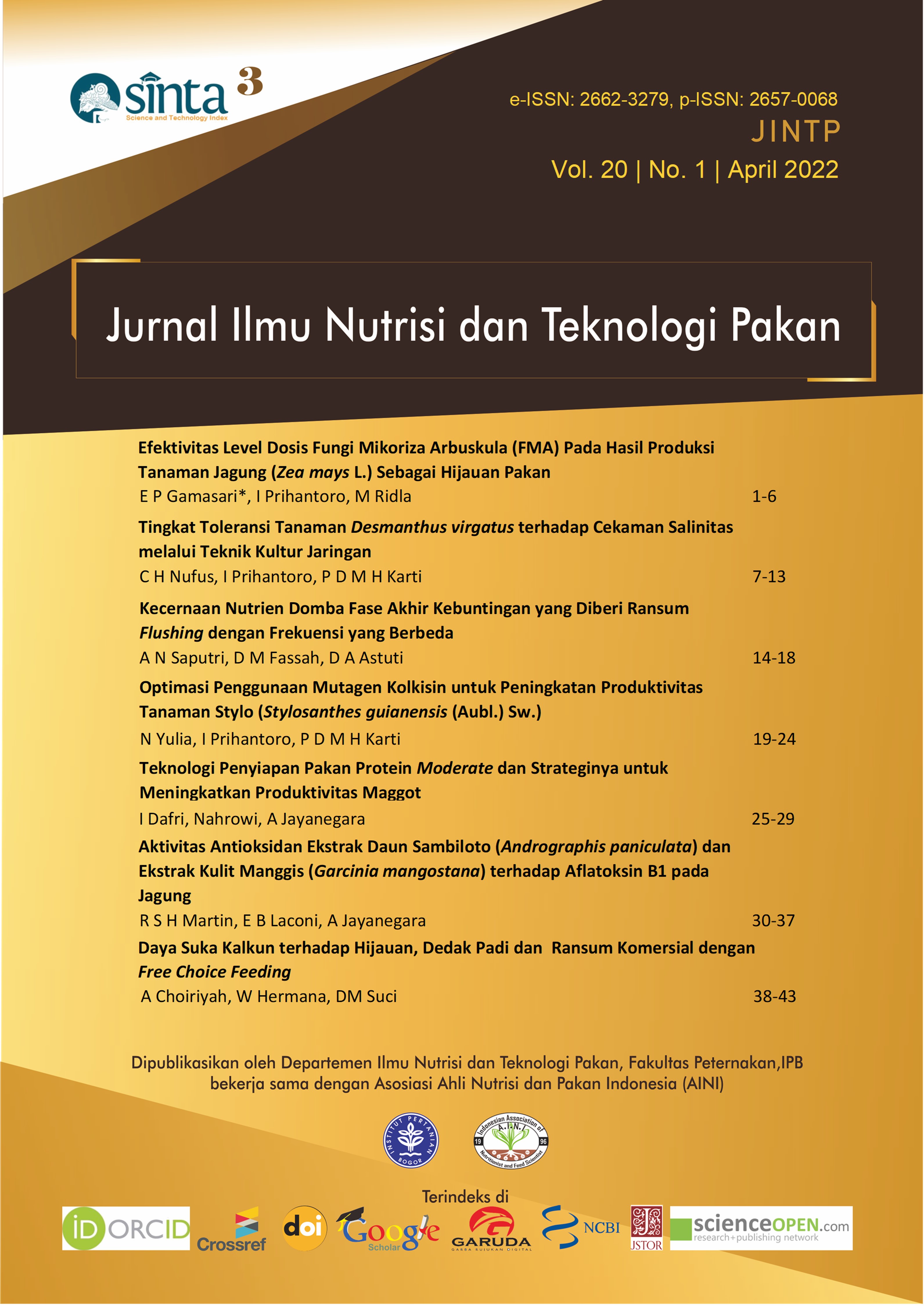Teknologi Penyiapan Pakan Protein Moderate dan Strategi Penyiapannya untuk Meningkatkan Produktivitas Maggot
Preparation Technology of Moderate Protein Feed and Its Strategy to Increase Maggot Productivity
Abstract
The aim of this research was to prepare moderate protein diet and evaluate its quality to increase maggot productivity. This research was conducted from the egg stage to the pre-pupae stage. One gram of larval eggs was used for each replication. The substrates used were fruit waste, household waste, and concentrate diet. This study used a completely randomized design with 2 treatments and 6 replications. Treatments were P0 (control feed of fruit waste and household waste) and P1 (moderate protein treatment feed). Control feed and moderate protein treatment were given as much as 13 kg during maintenance. The variables measured were dry matter consumption (grams), maggot weight (grams), pre-pupae percentage, substrate reduction (%), FCR, bioconversion (%), and WRI (Waste Reduction Index). Data were analyzed using paired sample T test. The results showed that BSF larvae receiving moderate protein treatment were significantly higher (p<0.05) compared to control feed for substrate consumption parameters, substrate reduction, and WRI. The conclusion from this research is the quality of feed with moderate protein content of 18,30 % which was prepared using a crude protein and energy balance approach was better than feed based on papaya fruit waste and household waste seen from the aspect of increasing substrat reduction, improving performance, prepupa metamorphosis, and increasing bioconversion of BSF larvae.
Key words: bioconversion, larvae BSF, maggot, performance, waste
Downloads
References
Banks LJ, Gibson WT & Cameron, MM. 2014. Growth rates of black soldier fly larvae fed on fresh human faeces and their implication for improving sanitation. Tropical Medicine and International Health. 19(1): 14-22.
Bosch G, Zhang S, Dennis GABO & Wouter HH. 2014. Protein quality of insects as potential ingredients for dog and cat foods. Journal of Nutrition Science. 3:1-4
Diener S, Gutiérrez FR, Zurbrügg C & Tockner K. 2009. Are larvae of the black soldier fly Hermetia illu-cens-a financially viable option for organic waste management in Costa Rica. Di dalam : Diaz LR, Stegmann R. 12th International Waste Management and Landfill Symposium Sardinia : 2009 Oct 5-9. Cagliari (ITA): CISA Publisher. 6 pp.
Diener, S, Solano, NMS, Gutiérrez, FR, Zurbrügg,C. & Tockner, K. 2011. Biological treatment of municipal organic waste using black soldier fly larvae. Waste Biomass Valor. 2: 357-363.
Fahmi, M R. 2015. Optimalisasi proses biokonversi dengan menggunakan mini larva Hermetica illucens untuk memenuhi kebutuhan pakan ikan. Prosiding Seminar Nasional Masyarakat Biodiversitas Indonesia. 1( 1) : 139-144.
Gobbi P, Martínez-Sánchez A & Rojo S. 2013. The effects of larval diet on adult life-history traits of the Black Soldier Fly, Hermetia illucens (Diptera: Stratiomyidae). European Journal of Entomology. 110:461-468.
Murni R, Akmal A, & Okrisandi Y. 2012. Pemanfaatan kulit buah kakao yang difermentasi dengan kapang Phanerochaete chrysosprium sebagai pengganti hijauan dalam ransum ternak kambing. Agrinak. 2(1) : 6-10.
Purba J, Kinasih I & Putra E. 2021. Pertumbuhan larva lalat tentara hitam (Hermatia illucens) dengan pemberian pakan pakan susu kadaluwarsa dan alpukat. Biotropika. 9(1) : 88-95. DOI: 10.21776/ub.biotropika.2021.009.01.10
Rachmawati, Buchori D, Hidayat P, Hem S & Fahmi RM. 2010. Perkembangan dan kandungan nutrisi larva Hermetia illucens (Linnacus) (Dipteria : Stratiomyidae) pada bungkil kelapa sawit. Journal Entomologi Indonesia. 7(1) : 28-41.
Suciati, R. & Faruq, H. 2017. Efektifitas media pertumbuhan maggots Hermetia Illucens (lalat tentara hitam) sebagai solusi pemanfaatan sampah organik. Biosfer. Jurnal Biologi dan Pendidikan Biologi. 2(1):8-13.
Supriyatna, A. & Putra, R.E. 2017. Estimasi pertumbuhan larva lalat black soldier (Hermetia illucens) dan penggunaan pakan jerami padi yang difermentasi dengan jamur P. chrysosporium. Jurnal Biodjati. 2(2):159-166.
Tomberlin JK, Adler PH & Myers HM. 2009. Development of the Black Soldier Fly (Diptera: Stratiomyidae) in relation to temperature. Enviromental Entomo. 38:930-934.
Tomberlin, J K, Sheppard, D C, & Joyce, JA. 2002. Selected life-history traits of Black Soldier Flies (Diptera: Stratiomyidae) reared on three artificial diets. Annals of the Entomological Society of America. 95:379-386.
doi.org/10.1603/0013 8746(2002)095[0379:SLHTOB]2.0.CO;2.
Tschirner, M. & Simon, A. 2015. Influence of different growing substrates and processing on the nutrient composition of black soldier fly larvae destined for animal feed. Journal Insects Food Feed. 1: 249–259
Copyright (c) 2022 I Dafri, Nahrowi, A Jayanegara

This work is licensed under a Creative Commons Attribution 4.0 International License.
The authors of the submitted manuscript have to understand and agree that the copyrights published are held by Jurnal Ilmu Nutrisi dan Teknologi Pakan. Copyrights includes rights in reproducing, distributing and selling every section of articles in all forms and media. The copyright transfer form is signed by the corresponding author. The author”
• Creative Commons Attribution (CC BY)
you are allowed to:
Share – copy and redistribute the material in any medium or format
Adapt – remix, transform, and build upon the material
for any purpose, even commercially.
The licensor cannot revoke these freedoms as long as you follow the license terms.
Jurnal Ilmu Nutrisi dan Teknologi Pakan (Nutrition and Feed Technology Journal)

This work is licensed under a Creative Commons Attribution 4.0 International License.












